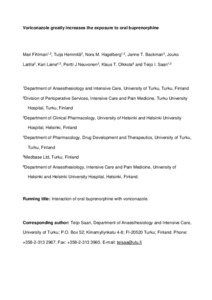Voriconazole greatly increases the exposure to oral buprenorphine
Mari Fihlman; Tuija Hemmilä; Nora M. Hagelberg; Janne T. Backman; Jouko Laitila; Kari Laine; Pertti J. Neuvonen; Klaus T. Olkkola; Teijo I. Saari
https://urn.fi/URN:NBN:fi-fe2021042719919
Tiivistelmä
Purpose: Buprenorphine has low oral bioavailability. Regardless of sublingual administration, a notable part of buprenorphine is exposed to extensive first-pass metabolism by the cytochrome P450 (CYP) 3A4. As drug interaction studies with buprenorphine are limited, we wanted to investigate the effect of voriconazole, a strong CYP3A4 inhibitor, on the pharmacokinetics and pharmacodynamics of oral buprenorphine.
Methods: Twelve healthy volunteers were given either placebo or voriconazole (orally, 400 mg twice on day 1 and 200 mg twice on days 2–5) for 5 days in a randomized, cross-over study. On day 5, they ingested 0.2 mg (3.6 mg during placebo phase) oral buprenorphine. We measured plasma and urine concentrations of buprenorphine and norbuprenorphine and monitored their pharmacological effects. Pharmacokinetic parameters were normalized for a buprenorphine dose of 1.0 mg.
Results: Voriconazole greatly increased the mean area under the plasma concentration–time curve (AUC0–18) of buprenorphine (4.3-fold, P < 0.001), its peak concentration (Cmax) (3.9-fold), half-life (P < 0.05), and excretion into urine (Ae; P < 0.001). Voriconazole also markedly enhanced the Cmax (P < 0.001), AUC0–18 (P < 0.001), and Ae (P < 0.05) of unconjugated norbuprenorphine but decreased its renal clearance (P < 0.001). Mild dizziness and nausea occurred during both study phases.
Conclusions: Voriconazole greatly increases exposure to oral buprenorphine, mainly by inhibiting intestinal and liver CYP3A4. Effect on some transporters may explain elevated norbuprenorphine concentrations. Although oral buprenorphine is not commonly used, this interaction may become relevant in patients receiving sublingual buprenorphine together with voriconazole or other CYP3A4 or transporter inhibitors.
Kokoelmat
- Rinnakkaistallenteet [27094]
